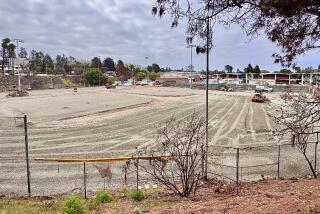Rebuilt to Last
- Share via
GRANADA HILLS — The Northridge earthquake crippled Van Gogh Street Elementary like no other school in Los Angeles nearly four years ago, ripping deep fissures in classroom floors and forcing students to abandon their campus to the wrecking ball.
Today, the 19 teachers and 400 students of Van Gogh will officially reopen their school, whose buildings have been designed to withstand devastating temblors. Standing amid vegetable gardens and mulberry trees, they will inaugurate the new ranch-style campus that looks equal parts elementary school and country manor.
Fifth-graders will read poems. District dignitaries will give speeches. And teachers will get one more chance to boast about the $6.3-million creation--the drinking fountain in every room, the wood-paneled auditorium, the amphitheater and grassy area for skits, the cabinets to store neatly boxed-up school supplies.
“It’s so nice to be home,” said Shana Stage, a first-grade teacher. “It’s a really comfortable place to come and be.”
Built in 1968, Van Gogh had consisted of one large school building, an auditorium and a kindergarten building. The structures were damaged in the Sylmar earthquake three years later, and then the Northridge earthquake opened patched cracks and carved hundreds of new fissures.
The damage was so extensive that district officials closed the school and awaited the results of geological studies rather than risk injury to students or teachers. The site’s geology was ultimately deemed sound, but repairing the structures was so costly that the district decided to demolish them and rebuild, using funds from the Federal Emergency Management Agency and the state. It was the only school in Los Angeles to be razed as a result of the earthquake.
Designers replaced the main structure with five smaller ones, while the auditorium and kindergarten building also were rebuilt.
They also made important structural changes to protect the school against future earthquakes, buttressing the buildings with loads of concrete and other materials.
Work crews installed 18-inch-thick concrete slabs with two layers of steel reinforcing bars beneath the floors in place of the four-inch-thick slabs that split in the Northridge earthquake. The new slabs are two feet thick around the perimeter of each building.
Additional wood panels were added to walls to resist earthquake forces. And shelters that protect against sun and rain were left free-standing so they would not pull on school walls if the ground moves.
Officials said they are confident that the school can withstand an earthquake similar to the one that hit on Jan. 17, 1994, registering magnitude 6.7.
“These are sound structural buildings,” said Ted Christensen, the structural engineer on the project. “You can say that without any problem.”
The school’s teachers and administrators say they feel safe at the school and have no qualms about returning.
“If we have another quake, this is where I’d want to be,” said Principal Maureen Diekmann.
In many ways, Diekmann and her staff are returning to a state-of-the-art school. Classrooms are wired for computers and the Internet and have adjoining “ante rooms”--quiet spaces where students can work on computers or listen to tapes with earphones. Meanwhile, each building has restrooms, a big change from Frost Middle School, whose cramped bungalows housed Van Gogh from early 1994 until this past August, when the school prepared to reopen last month. There, students had only one set of restrooms. Also, Frost’s playground was only a fraction of Van Gogh’s size, teachers said.
Then there are the gardens of peas, lettuce, spinach and other vegetables cultivated by the students outside their classroom doors.
Kami Caskey, a fifth-grader who moved with her fellow students to Frost after the earthquake, could not recall anything at the middle school as enjoyable as the garden she is growing--part of a lesson on plant growth and water erosion.
“We all have our own private gardens for the classrooms,” said Kami, 10, as she sprayed water on a mound of dirt that will soon yield her favorite vegetable, Swiss chard. She paused to ponder other benefits of the new school: “The playground is really, really big,” she said.
Kami’s teacher, Joy Jones, echoed her students’ enthusiasm for the new school, nestled at the base of scrubby hillsides and across the street from a small park that has a stream running through it.
“It’s heaven,” she said. “It’s a wonderful environment to be working in. This is ours.”
More to Read
Sign up for Essential California
The most important California stories and recommendations in your inbox every morning.
You may occasionally receive promotional content from the Los Angeles Times.













